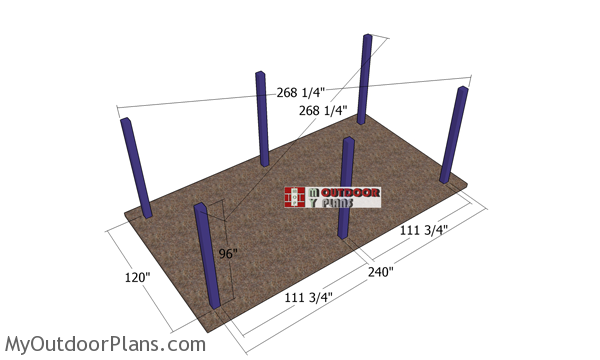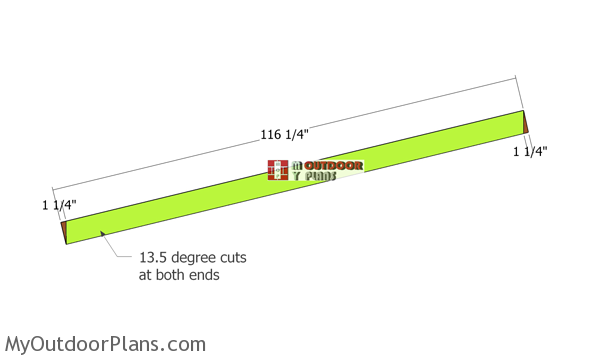This step by step diy woodworking project is about a 10×20 wooden pavilion with lean to roof plans. This is one of the most common pavilion sizes, therefore I had to design this with a lean to roof, as well. The pavilion features a 10 ft x 20 ft base with a sturdy 6×6 structure and with a convenient lean to roof, that will provide plenty of shade and keep the costs down. Take a look over the rest of our woodworking plans, if you want to get more building inspiration. Check out the Shop, as well, for full list of Premium Plans.
When buying the lumber, you should select the planks with great care, making sure they are straight and without any visible flaws (cracks, knots, twists, decay). Investing in cedar or other weather resistant lumber is a good idea, as it will pay off on the long run. Use a spirit level to plumb and align the components, before inserting the galvanized screws, otherwise the project won’t have a symmetrical look. If you have all the materials and tools required for the project, you could get the job done in about a day.
Projects made from these plans
10×20 Lean to Pavilion – Free DIY Plans

Building-a-10×20-lean-to-pavilion
Materials + Cut Lists
- A – 6 pieces of 6×6 lumber – 8′ long POSTS
- B – 2 pieces of 6×6 lumber – 10′ long, 2 pieces – 136″ long TOP PLATES
- C – 3 pieces of 6×6 lumber – 10′ long TOP PLATES
- D – 12 pieces 6×6 lumber – 36″ long BRACES
- E – 3 pieces of 6×6 lumber – 32 3/4″ long RIDGE BEAM SUPPORTS
- E – 2 pieces of 6×8 lumber – 136″ long RIDGE BEAMS
- F – 2 pieces of 6×6 lumber – 116 1/4″ long BRACES
Tools
![]() Hammer, Tape measure, Framing square, Level
Hammer, Tape measure, Framing square, Level
![]() Miter saw, Drill machinery, Screwdriver, Sander
Miter saw, Drill machinery, Screwdriver, Sander
Time
Related
- PART 1: 10×20 Lean to Pavilion Plans
- PART 2: 10×20 Lean to Pavilion Roof Plans
10×20 Lean to Gazebo – Free DIY Plans

Laying-out-the-posts—10×20-pavilion
First, layout the posts for the 10×20 garden pavilion. Use batter boards and string to determine the location of the posts. Apply the 3-4-5 rule to every corner of the pavilion, so you make sure they are right angled. Make sure the diagonals are equal. We are going to use 6×6 posts for this pavilion project.
Determining the location for the pavilion is essential, as you have to comply with the local building codes. Make sure the surface is level and remove the vegetation layer. Before pouring the concrete you need to make sure the top of the posts are horizontal one to another. Use a laser to mark the level to the top of the posts and use a circular saw, if you need to make cuts.

Anchoring the post into concrete
Dig 3 ft holes into the ground, making sure they have about 16″ in diameter. Fit the tubes then the posts into the ground and plumb them with a spirit level. Let the concrete dry out for several days. Read the local codes for more details on how to secure the posts. Install the anchors.
Fit the posts to the anchors and plumb them with a spirit level. Use temporarily braces to make sure the posts are locked into placed while filling the holes with concrete. Use lag screws to secure the posts to the anchors.
Building the frame of the pavilion

Top-plates—10×20-lean-to
Use 6×6 lumber for the top rails. Mark the cut lines on the beams and then make the cut outs with a circular saw and a chisel. Smooth the surface with sandpaper. Set the circular saw at 2 3/4″ and then make parallel cuts inside the marked areas. Clean the recess with a chisel and sandpaper. You can also get the job done with a jigsaw, but it will take longer.

Fitting-the-side-top-plates
Fit the top rails to the sides of the pavilion. Notice the 16″ overhangs to the back of the pavilion. Drill pilot holes through the plates and insert 8″ screws to lock them to the posts. Use 2 screws for each joint. Make sure the corners are square and plumb the posts vertically, before attaching the support beams. Don’t get the ladder against the posts when installing the plates, because you will move them from position.

Fitting-the-cross-beams
Fit the cross plates to the pavilion. Align the edges flush and drill pilot holes. Insert the 8″ screws to lock the cross plates into place tightly. Check if the corners are square after installing the plates.

Fitting-the-braces-to-the-frame-of-the-pavilion
Build the braces for the frame of the pavilion from 6×6 lumber. Use a miter saw to make 45 degree cuts to both ends of the braces. Fit the braces to the posts, after you plumb them vertically. Drill pilot holes and insert 5 1/2″ screws to secure the braces into place tightly. Also, you need to make sure the corners are square before attaching the diagonal braces.
Attaching the ridge beam

Fitting-the-ridge-beam-supports
Fit the 6×6 supports to the top of the pavilion. Use 2 L shaped connectors to secure the side supports. Insert 2 1/2″ structural screws to lock the connectors into place. Plumb the supports with a spirit level before securing them into place tightly. Making these supports longer or shorter will influence the pitch of the roof, so you might pay attention to this step, if you don’t like the 4:12 shown in my plans.

Fitting-the-ridge-beams
Fit the 6×6 ridge beams to the top of the supports, making sure the overhangs are equal on both sides. Use post to beam connectors and 2 1/2″ structural screws to secure the beams into place. Use a spirit level to check if the beams are perfectly horizontal.

Diagonal-top-braces
We also need diagonal braces for the ridge beam. Use a miter saw to make the angle cuts to both ends of the braces, as shown in the diagram. These beams will add extra rigidity to the structure of the pavilion, so you can enjoy it even during strong winds.

Fitting-the-top-diagonal-braces
Use 6×6 lumber for the diagonal braces that will reinforce the middle ridge beams. Make 45 degree cuts at both ends of the braces. Secure the braces into place with 5 1/2″ screws. Drill pilot holes before inserting the screws.

How-to-build-a-10×20-lean-to-pavilion
Check out PART 2 of the project to learn how to build the lean to roof for this large slanted gazebo.

10×20-Lean-to-Pavilion-side-view
Fill the holes with wood putty and let them dry out for a few hours. Smooth the surface with 100-220 grit sandpaper and remove the residues with a damp cloth.
Top Tip: Apply a few coats of paint or stain to the components, to enhance the look of the project. Premium Plans for this project available HERE. Check out the Shop, as well, for full list of Premium Plans. If you want to get PREMIUM PLANS for this project, in a PDF format, please press GET PDF PLANS button bellow. Thank you for the support.
This woodworking project was about 10×20 pavilion with lean to roof plans free. If you want to see more outdoor plans, check out the rest of our step by step projects and follow the instructions to obtain a professional result.


